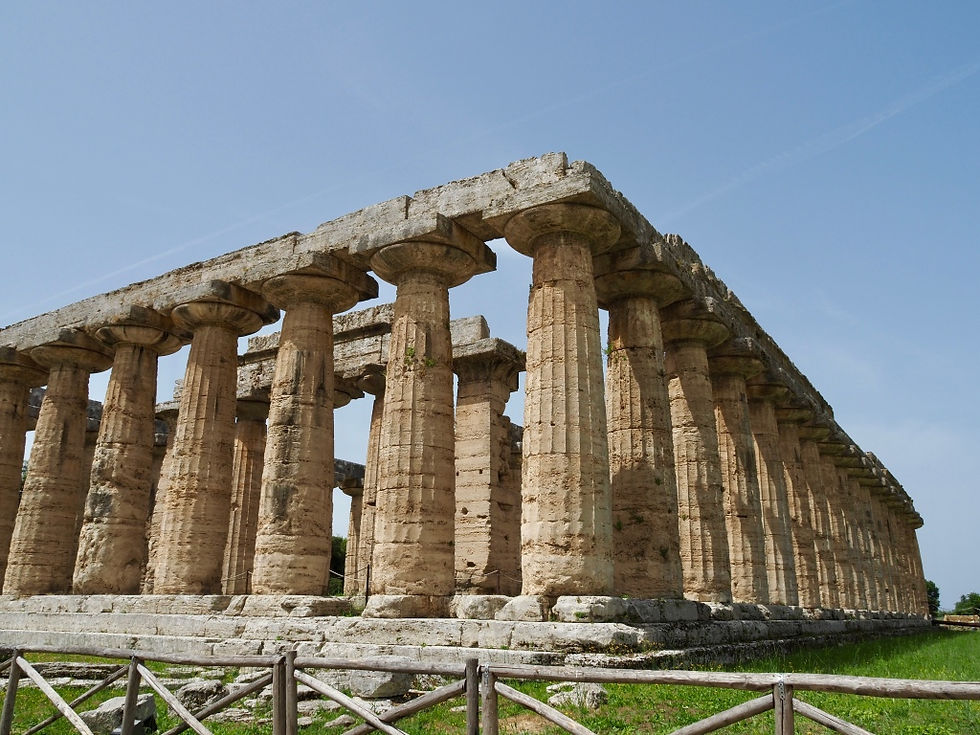Paestum
- sbcrosby .

- May 26, 2022
- 3 min read
Updated: Aug 12, 2023
We ventured southeast this morning, winding our way along this beautiful Amalfi coastline and through multiple small villages, including Ravello, Minori, Maiori, Vietri (famous for its Italian pottery and ceramics), and Salerno. We then headed south to the Ancient Greek settlement of Paestum. This ancient city was founded in 600 B.C., with the original name of Poseidonia, and holds some of the most well-preserved Greek temples in the world.
The perimeter walls spanned 5 kilometers in length, and contained three large and many small temples, with a massive agora, or city center, where trading took place. The site was presumed to be chosen by the Greek colonists for its fertile land, access to nearby rivers for a water source (there were no aqueducts in this part of Italy at that time), and nearby sea port.

The first temple, known as the Temple of Hera, was built around 550 B.C., and is believed to have taken 30 years to complete. It was unusual for a Doric temple, as it has an uneven number of front columns (nine). Hera was Zeus’ wife and was the goddess of fertility, motherhood, and family.

The second temple was the Temple of Athena, goddess of strategic war and wisdom. She was often portrayed in her full armor and with an olive branch. Its facade contains six fluted columns, with 13 columns spanning the sides of this magnificent architecture. Athena’s Temple was built around 500 B.C.

The largest and most prominent temple was Poseidon’s Temple (also known as the Temple of Hera II). It’s considered the most well preserved Greek temple in the Western world. Most modern-day archeologists believe this temple was actually built for Zeus, given its size and stature, and given the position of Hera’s temple on its left. In fact, remnants of a statue of Zeus were found within its ruins. This third temple was built in approximately 450 B.C., and took approximately 50 years to complete.

In about 280 B.C., the Romans conquered Poseidonia and changed the name to Paestum. They tore down the Greek agora and replaced it with a traditional Roman forum, complete with an amphitheater. The town was occupied around 400 A.D., the area was converted to Christianity, the interior chamber of the Temple of Athena was removed, and the temple was converted to a church.

About 400 years later, the city was entirely abandoned due to pirate attacks and encroaching barbarians. Many centuries later, archeologists have uncovered significant ruins on this land. However, only about 30% of the original city has been excavated; the rest is on private land. Other than the three temples and the amphitheater, the majority of this ancient city’s remains are mainly portions of foundations and walls. That said, this spectacular ancient site is well worth a visit.
After touring a portion of the Paestum Museum (several rooms were closed for renovations), we enjoyed a refreshing gelato and then made our way back toward Amalfi.

The headstone of a man’s burial tomb, circa 400 B.C.
Our one stop in Minori certainly did not disappoint! We decided to grab lunch at Sal de Riso’s Ristorante, made famous for its Delizia al Limone by Stanley Tucci’s “In Search of Italy." An absolute MUST when visiting the Amalfi coast. Not only did I have the best pizza I think I’ve ever eaten (my favorite Neapolitan “capricciosa”), we ended with delectable desserts including the famed Limone cake. We may or may not have brought back a couple of extra desserts for after dinner!
We enjoyed the remainder of today poolside at our beautiful hotel, taking in the Mediterranean views of this incredible property. Tonight, we’ll eat at our hotel, and then pack up for our journey back to Rome in the morning! Until next time, Caio!













Comments